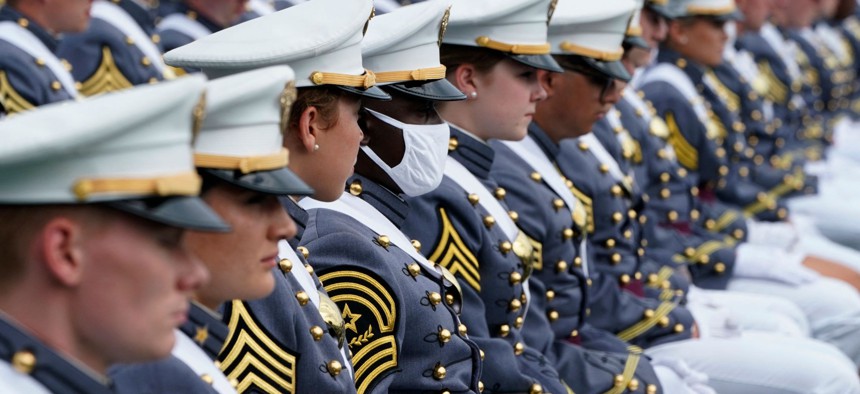
The Class of 2021 at the US Military Academy's graduation ceremony at Michie Stadium in West Point, New York, on May 22, 2021. AFP via Getty Images / TIMOTHY A. CLARY
Reports of Sexual Assault, Harassment at Military Academies Spike
The number of reports likely still represents only a small portion of actual instances of sexual assault and harassment.
The number of reports of sexual assault and harassment at the military service academies increased by half last year—the highest number of reports since the Defense Department first started collecting this data.
Pentagon officials say it’s a move in the right direction for reporting, as the academies make slow progress toward a goal of 100% of sexual assaults reported. But the numbers also show that despite decades of efforts to prevent these crimes, they are still prevalent.
During the 2020 to 2021 academic year, cadets and midshipmen from all the military service academies submitted a total of 131 reports of sexual assault or harassment—a roughly 50% increase from the 2019 to 2020 academic year’s 88 reports.
The 50% increase is a sharp one from the unusually low number of reports in the 2019-2020 academic year. But DOD officials estimated that without the impact of the COVID-19 pandemic, the AY 19-20 numbers would have been higher and more in line with the steady upward trend.
“The reason why there was a dip last year is because, again, the academies closed right at the beginning of the fourth quarter of the academic program year and sent everyone home,” Nate Galbreath, acting director of the Sexual Assault Response Prevention Office, told reporters Thursday. “Once everyone went home, there were no further reports of sexual assault at the academies.”
Using quarterly data from the previous two years, DOD estimated that the number of reports from academic year 2019 to 2020 would be close to 122 reports had the academies not sent students home.
The most recent increase follows the upward trend in total number of reports, which military officials argue is a sign that cadets and midshipmen are becoming more comfortable reporting sexual assault and harassment.
The Defense Department collects data on sexual assaults and harassments at the academies in two ways. During even-numbered academic years, DOD just collects data on how many sexual assaults and harassments are reported through official channels. During odd-numbered academic years, DOD collects survey data on the prevalence of sexual assault and harassment, whether it is officially reported or not. One of DOD’s eventual goals is to reach a point where the number of reports aligns with the number of instances—meaning every instance of sexual assault or harassment is reported.
They still have a long way to go.
The most recent full set of data—data on reports and prevalence—is from the 2017 to 2018 academic year. No prevalence survey was conducted for the 2019 to 2020 academic year due to the pandemic. From 2017 to 2018, anonymous surveys revealed 747 instances of sexual assault or harassment, but only only 92 reports of sexual assault or harassment were filed.
“That’s 12 percent of the 747 that we estimated were out there,” Galbreath said. “So our goal is to get that to 100 percent. We would like to see every sexual assault reported so that everybody can seek care. We know we're a long way off from that.”
The most recent report also includes information about a number of new approaches, strategies, and resources that DOD has taken to try to decrease the number of assaults and increase the number of reports. For example, three cadets or midshipmen who experienced sexual assault or harassment were offered “expedited” transfers to other academies. The “Safe to Report” policy also allows cadets and midshipmen to report instances of sexual assault or harassment without fear of punishment for underaged drinking or other similar misconduct associated with the event.
DOD also worked to identify the “influencers” within cadet and midshipmen student bodies, in an effort to change the attitudes and culture at the academies.
“We asked about norms on the campus. We asked students to tell us who's influential on campus. And we then, we use those lists of influential students and recruited those particular influential students to participate in focus groups,” Ashlea Klahr, director of health & resilience research with the Office of People Analytics said.
The focus groups showed that the influencers on campus were all very interconnected, were mostly male, and were mostly nominated by other males.
“And so therefore, the best bet for shaping the attitudes and behaviors of men in particular is still working through male influencers,” Klahr said.
These new efforts are all part of what Defense Secretary Lloyd Austin called an “unprecedented and historic focus on sexual assault and sexual harassment within the force,” which he began shortly after stepping into his role.
Correction: An earlier version of this article contained an error in the headline and first paragraph. The number of reports increased by about half from the previous academic year.
